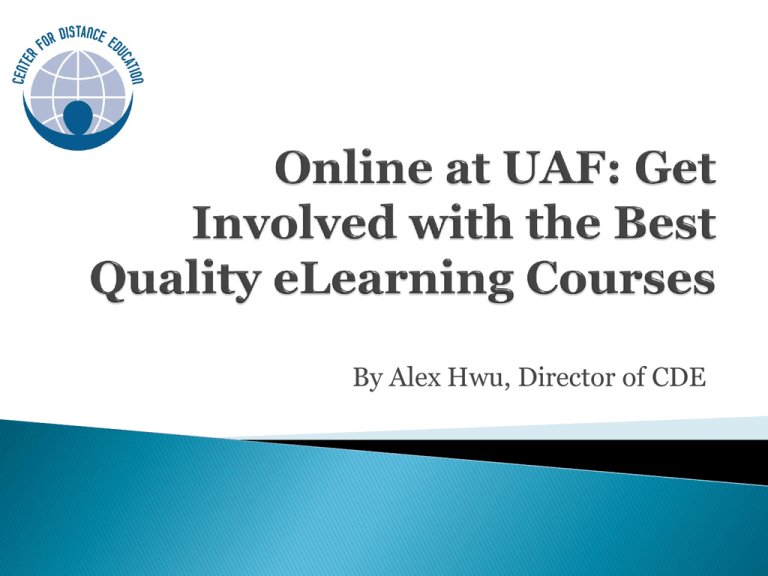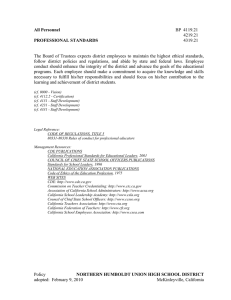By Alex Hwu, Director of CDE
advertisement

By Alex Hwu, Director of CDE CDE is a part of the College of Rural and Community Development (CRCD) Enrollment in courses delivered through CDE is approximately 6500 annually, generating more than 20,000 student credit hours (SCH). CDE’s enrollment has increased by an average of 8 to 10% each of the last 3 years. CDE serves over 4300 individual students annually, 70% of them UAF main campus students or students residing in the Fairbanks area, 21% outside Fairbanks, and 9% outside Alaska. CDE’s student age distribution: 53% are 19-25, 19% are 26-30, and 28% are 30+ years old. Demographic Distribution Outside AK AK AK Demographic Distribution REST of AK Military Fairbanks NorthPole 9% 11% 34% 50% 91% 5% CDE Students M-F Ratio F Student Age Distribution M 19-25 26-30 30 & Up 28% 31% 53% 69% 19% Lower 48 Demographic Distribution VT 0% RI NJ 0% 0% NH CT 0% 0% AE 4% WA 17% NY PA 1% 0% VA 5% OR 1% HI 3% GA 5% FL 5% KY 2% CA 8% OH IN 1% 2% NV 4% WI 5% NM 7% AZ 2% UT 2% ID 0% WY 4% CO 3% TX 4% LA 2% MN MT 2% IL 1% 2% MO 1% IA MI 0% 2% CDE offers around 140 courses, which includes some print based courses. CDE student services staff processed nearly 65,000 individual student lessons last year CDE facilitated courses (from this point on referred to as simply “CDE Courses”) are offered cooperatively through 38 UAF academic departments. Currently there are approximately 80 instructors teaching for CDE, approximately 85% of whom teach— or have taught—at UAF or other higher education institutions. Department approval before CDE begins development of a course Department approval of the developer (faculty who will be developing or revising the course) CDE course design review and approval by instructional designers utilizing the CDE Rubric and design checklist Department review and approval of the course content, verifying that it meets department academic standards and outcomes for the course designator, as defined by department curriculum group(s) Department approval of the instructor(s) for a course (usually the same faculty who developed it, but not always) “Reverse Engineering” from outcomes to activities by way of evidence-based assessment of understanding, turning the process away from disconnected activities that are not coherently tied to learning objectives Development emphasis on: ◦ Learning community within the classroom ◦ Facilitating the three vectors of interaction between student, instructor and curriculum ◦ Integrating place-based knowledge, information and activities ◦ Creating activities that bring the “real world” and media into the classroom ◦ Providing access to—and practices for working within—socially networked environments, inside the classroom and out A foundation for online courses that promotes “Information Fluency”—the combination of: ◦ discipline/course specific information and resources ◦ application of critical thinking skills and techniques ◦ presentation and participation tools and skills Consideration of how activities and materials promote development of the students’ Personal Learning Environments (PLE) and Project Based Learning (PBL) Traditional students are comprised of: ◦ Semester-based/UAF degree seeking students who register using UAOnline or their local registrar and purchase materials from the CRCD Book Store ◦ Semester-based/(UAA and UAS) degree seeking students who register using UAOnline or their local registrar and the CRCD Book Store mails books and materials ◦ Semester-based/Non-degree seeking students from all three UA campuses as well as other institutions who transfer credits to their home institution later or take advantage of existing articulation agreements CDE also services non-traditional students with “yearlong” courses which do not require formal admission to UAF and for which all students are charged in-state tuition. Nontraditional students include: ◦ Students wanting core courses out of the way before they become degree seeking ◦ Students who cannot attend a campus course; i.e. single parent, full-time working people, continuing education ◦ Students wanting to take refresher courses ◦ Teachers seeking re-certification and step increases ◦ High school students—both home schooled and students from Fairbanks or surrounding areas—taking courses they can’t otherwise acquire (higher levels of math, for instance) ◦ Senior citizens ◦ Military Personnel ITEACH ◦ iTeach is the flagship of faculty development at the University of Alaska providing intensive, personalized, practical faculty development in teaching and learning technology and pedagogy. More than 175 faculty members from every region of the state have participated in iTeach seminars. IDESIGN ◦ The annual iDesign conference hosted by CDE pulls together instructional designers from within the University of Alaska as well as other educational and vocational institutions around the state who provide similar types of faculty support for distance education courses. Through face to face workshops, Elluminate Live! web conferencing and audio conference meetings, and provision of internet resources, this group has the opportunity to learn from one another and to explore topics that affect the philosophy, process, and production of curriculum for higher education. DISTANCE EDUCATION GATEWAY ◦ The statewide Distance Education Gateway continues to be developed, maintained and operated by CDE staff in conjunction with UA Statewide. The Gateway provides the only centralized point for students and prospective students to learn about distance learning options across the entire University system and will play a major role in the future. CDE continues to seek improvement in their offerings and take advantage of emerging pedagogies and technologies to meet student and institutional needs. The administration, staff and instructors at CDE look forward to new opportunities including investigating new models of course delivery and instructor compensation, Working on creating open resources for students and faculty, extending the functionality and services of the Distance Gateway. And cooperative service agreements with departments with an eye toward helping departments reach their goals while offering more options for distance education students including complete degree programs. Increase both online student retention and success rate. CDE new quality improve program (QIP). Increase collaboration with school/college based on new 60/40 tuition funding model. ◦ Increase interaction between students and instructor through social networking. ◦ Create more synchronized learning activities. ◦ Create online orientation for students and faculty. ◦ Establish CDE ticket system to track students’ issues and resolution. ◦ Provide additional professional development for all online instructors. ◦ Create faculty online communities. ◦ Hiring additional instructional designer, LMS Coordinator and student academic advisor. ◦ Increase academic oversight on both online courses and programs. ◦ Grow online teaching capacity within each school and college. ◦ Develop new online programs and certificates. Faculty Development for Specific School and College. ◦ Two days workshop on how technology can facilitate teaching. CDE tuition revenue sharing with School and College ◦ Partnership with departments to meet students’ need and demand ◦ Increase online instruction capacity within each department ◦ Assist department on potential TA and RA funding Scenarios Pays instructor Tuition split Student/Faculty Support and Instructional Design CDE course CDE 90% CDE CDE 10% College/School CDE course College/School 40% CDE 60% College/School CDE Performance Metrics and Supporting Data FY05 Historical Performance FY06 FY07 FY08 FY09 Student Credit Hours Generated 16,158 17,766 17,267 18,705 19,724 Lower Divison SCH 12,450 13,436 13,049 13,869 14,729 Upper Division SCH 2,909 3,559 3,558 4,126 4,428 Graduate Division SCH 715 771 660 710 567 Professional Level SCH 84 0 0 0 0 1,313 1,288 1,310 1,485 Reporting Period: FY09 (July 1, 2008 to June 30, 2009) Undergraduate Enrollment, fall terms only (ex UY% ) 1,262 Graduate Enrollment, fall terms only (ex UY% ) 65 68 64 49 49 UA Scholar Enrollment, fall terms only (ex UY% ) 86 125 99 145 160 16000 14000 12000 2001 2002 10000 2003 2004 8000 2005 2006 2007 6000 2008 2009 4000 2000 0 Lower Upper Developmental Graduate 500-level

